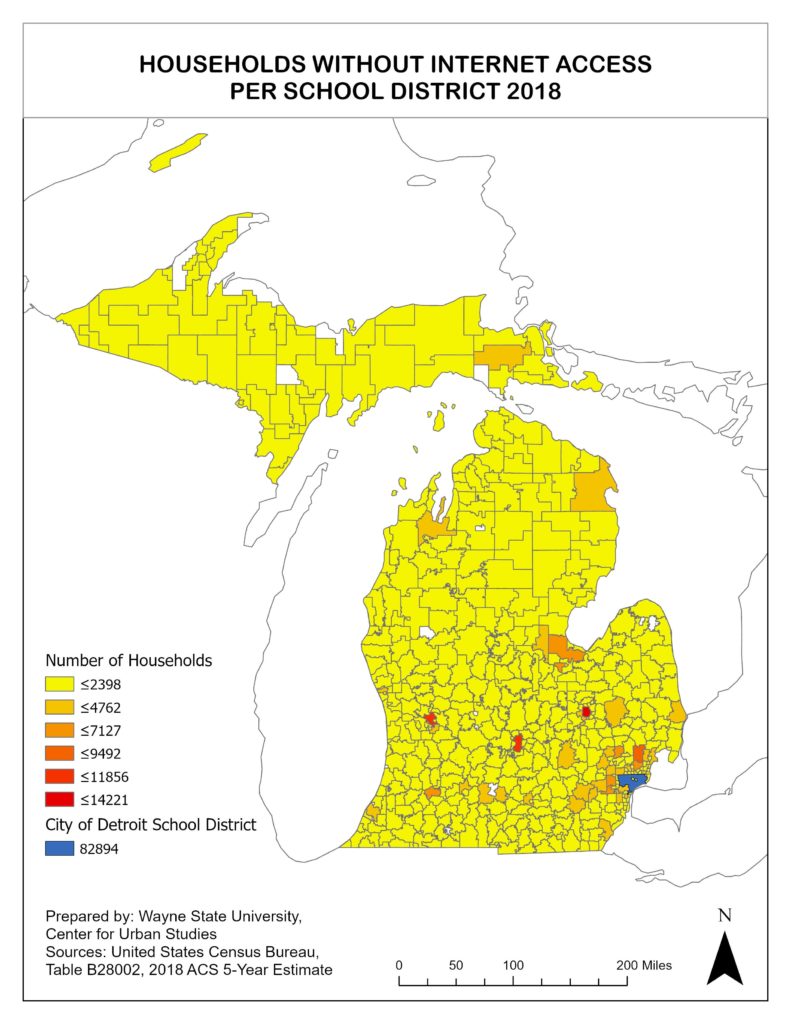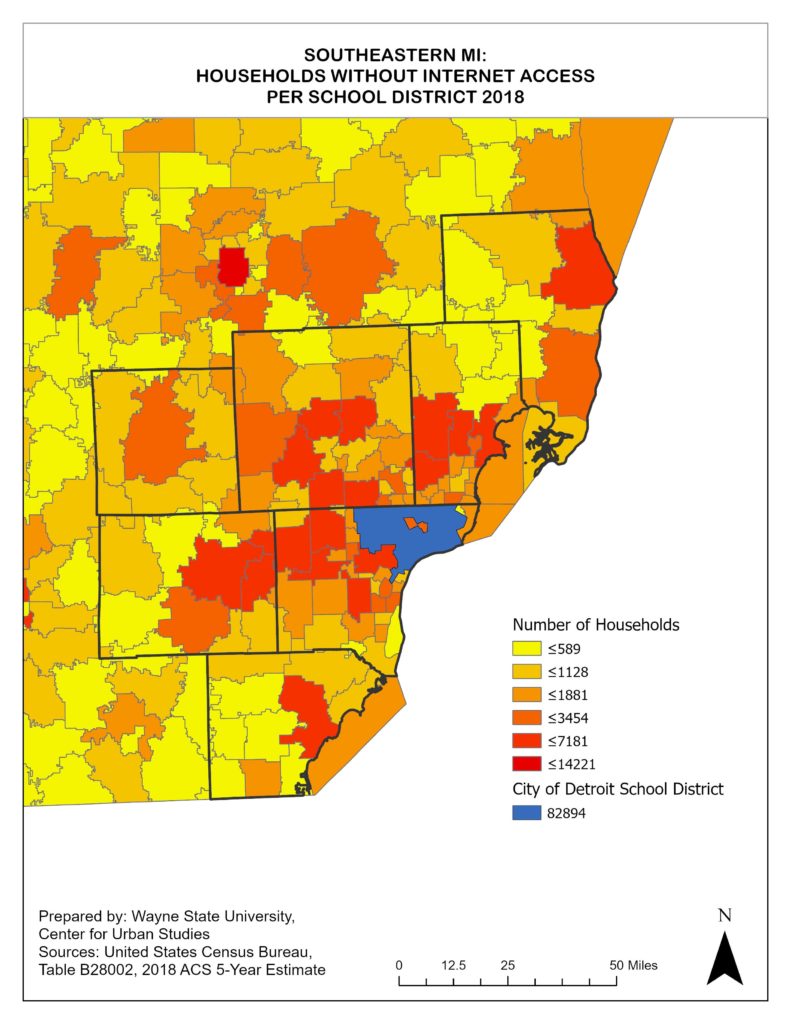There is a digital divide across the State of Michigan and across the country, largely related to socioeconomic factors. As the coronavirus hit the US that divide grew even wider as access to public and private places that normally provide amenities such as the internet and computers were shuttered. The divide also grew as students had to finish the school year from home, and thousands were left without computers or internet access. While schools had printed resources available to ensure students could complete the school year, the access to the digital world-or lack thereof-was substantial.
In the State of Michigan Detroit Public Schools had the highest number of households without internet access–82,894, according to the U.S. Census Bureau. The second highest number in Michigan was the Flint School District which had 14,221 households without internet access. Looking only at Southeastern Michigan, Utica Community Schools had the second highest number of homes without internet access (behind Detroit) at 7,181 homes. There were 5 times as many households in the Detroit Public Schools district without internet access than in the Flint School District and 11 times as many households in Detroit Public Schools than in Utica Community Schools without internet access. Detroit Public Schools is the largest district in the State.
While Detroit Public Schools is the largest district in the State it also provides education to students who live in some of the lowest median income households in the State. According to the U.S. Census Bureau, 47 percent of children in Detroit live below the poverty level. On the other end of the spectrum, Northville Public Schools is the wealthiest school district in the State with 1.4 percent of children living in poverty, according to the Census Bureau. There were only 755 homes within Northville Public Schools that did not have access to the internet.
As the Statewide map shows (below), the majority of the districts throughout Michigan had less than 2,400 homes without internet access. For several smaller districts, such as those throughout the northern part of the lower peninsula and all those in the upper peninsula and the west side of the State, the lower numbers are understandable due to the smaller number of students in districts. But, what stands out is the districts on the map that are red, orange or blue. These larger urban areas including Flint, Grand Rapids and Lansing were all in the districts with the higher numbers of households without internet access.
The second map shows a more concentrated look at Southeastern Michigan. This highlights how several school districts closer to Detroit also had a higher number of homes without internet access. Some of these are also low or moderate income communities. For example, the lower half of Macomb County, which is more urban and densely populated, has four school districts where between about 7,200 and 14,000 households do not have access to the internet.
According to the article “The Effects of Home Computers on Educational
Outcomes: Evidence from a Field Experiment with Community College Students” published in The Economic Journal, access to computers and the internet improves students’ skills to getting school work completed, which in turn improves educational outcomes. The Skillman Foundation, DTE Energy, General Motors and Quicken Loans have all worked to provide laptops to Detroit Public Schools students in need throughout this pandemic. Additionally, companies such as Comcast have opened their hotspots for more widespread internet access. However, the coronavirus has shed light on many different socioeconomic issues. The digital divide and its impact on distance learning is certainly one of them.
Internet access has arguably come close to a fundamental need for many day-to-day functions, including for schoolwork. The recognized need for the internet to aide in school work is supported by the recent partnerships, discussed above, with universities and corporations to provide access to those without it in the Detroit Public Schools district. Furthermore, in Kalamazoo, where 5,191 homes are without access in the public school district, a similar partnership was developed with the City through its Foundation for Aspirational Excellence Fund. This fund is supported through the City, the school district, the Kalamazoo Community Foundation and the Kalamazoo Promise. The director of the Kalamazoo Promise, Von Washington Jr., was recently quoted in MLive saying how the recent closure of public schools “exacerbated the educational inequities that are present in our community.”


As non-profits and corporations step up to, at least temporarily, fill the gap in internet access to ensure students can continue to learn, we must also ask what other ways the internet has become essential, especially during a pandemic. During the pandemic online doctors appointments were often the only access to medical care. Working remotely was mandated in many workplaces. Buying goods and groceries, via the internet has become a new way of life. Access to the internet has become so useful-even essential-in everyday life functions the United Nations passed a resolution in 2016 declaring it a human right. The partnerships discussed above related to the concerns of internet access for education equity also highlights how, at least nationally, more and more attention is being focused on the need for broadband access no matter where or who you are. Whether or not everyone will have access in the near future, and how that access will be supported-through public or private dollars, or combination of both-remains to be fully addressed though.